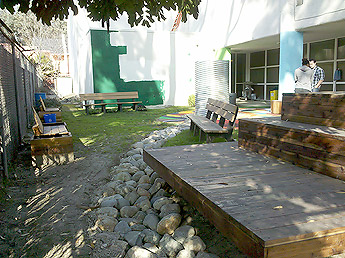“…more often than not people refer to the community as [just] people, but I think it’s a communion between the people and the environment…” –Kianna Nesbit, Principal of Youth Opportunities High School
People often talk about the need for more environmental leadership in our communities, but there’s sometimes a struggle with defining what that means. In fact, very often it’s difficult to envision the path to this goal, precisely because the options for doing so have never been set.
For a charter high school in Watts, South L.A., environmental leadership has been actualized through through a school garden project that will feature a cistern designed to capture and recycle rain water onsite. The name of the school is Youth Opportunities High, which is managed by the Los Angeles Conservation Corps (LACC) and offers at-risk local youth the opportunity to reach for a better future. The garden, the Watts Garden Community Plaza, is YO’s greening beautification project. The project was made possible through funding from the City of Los Angeles’ Office of Community Beautification, the California Coastal Conservancy, and the Liberty Hill Foundation.
Planning for the Watts Garden Community Plaza’s construction was facilitated through a set of capacity-building trainings for the teachers, parents, and students of the school, that Heal the Bay offered through its Healthy Neighborhoods, Healthy Environment initiative. As the garden project nears completion, the empowering effects of a community organizing effort to support of an environmental project have been inspiring.
While the cistern in the Watts Garden Plaza will make only a small contribution in capturing rain water and runoff, the garden as a whole will serve as a lasting educational tool, not only for Youth Opportunities High, but also for the surrounding community–embodying an example of how a “greening” project can be successfully undertaken by a small group of committed individuals. As an accompanying effort to the Watts Garden, Heal the Bay has assisting Youth Opportunities High in the development of an after-school environmental program: the Generation Green (which will provide an important service to the community by developing environmental stewardship in its youth).
The leading community organizer for the Watts Garden Plaza has been Youth Opportunities High’s Principal, Kianna Nesbit. For her, the first step towards cultivating stewardship has always been connecting people to the environment: “…the more you see it, the more you feel a connection to it. I think that’s another reason why people don’t see a connection to it, is because they don’t see it in their communities. There’s no water flow, streams, so people have no connection to it.”
Heal the Bay was introduced to Kianna by LACC over three years ago and we have since become allies in the shared fight against urban runoff and pollution in the streets of L.A. Last year Kianna joined us in Sacramento to ask our State legislators to do something about the problem of plastic pollution that plagues our city’s streets. The trash, created by a culture of disconnectedness, has an extreme impact on the Greater Los Angeles metropolitan area. Not only is it a eyesore across neighborhoods, but it travels as trash through the storm drain system and is discharged into the ocean, where it harms our precious natural resources.
The Watts Garden Plaza will start to visually connect the students of Youth Opportunities High to the process of how our water flows through our communities. The goal is that by taking this first step, the seeds of environmental stewardship will be firmly planted and given the chance to grow and spread.
Watch videos: “Healthy Neighborhoods Open House” »





